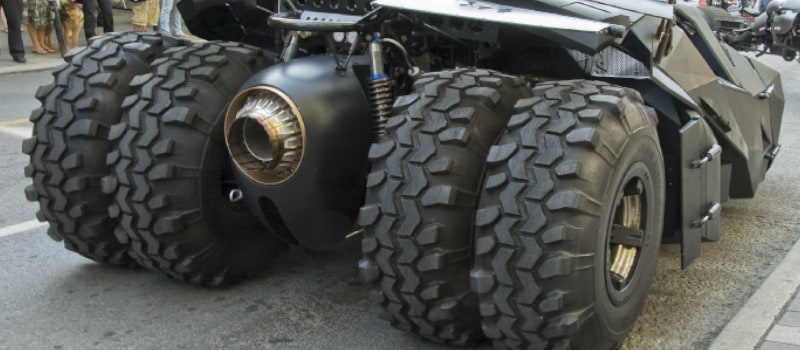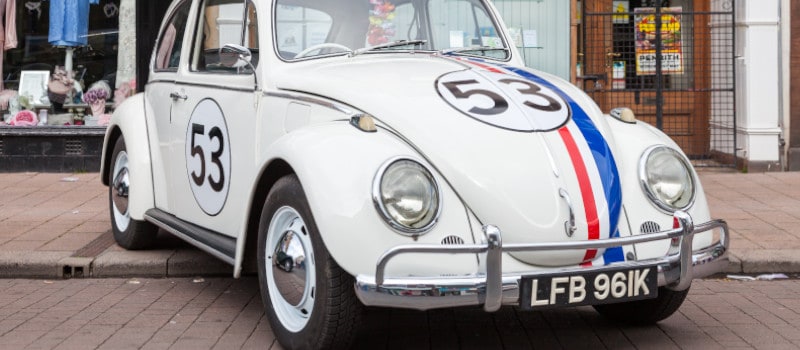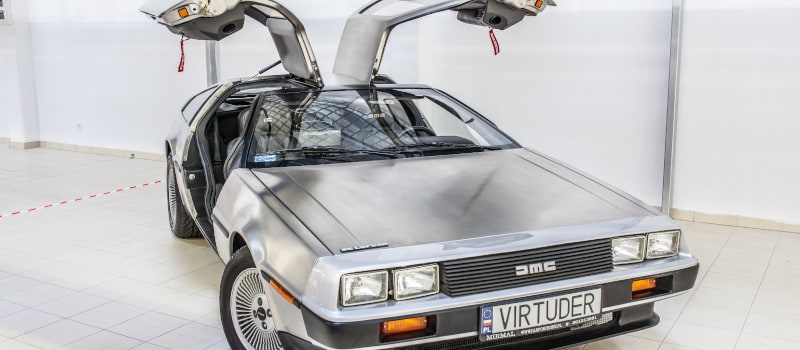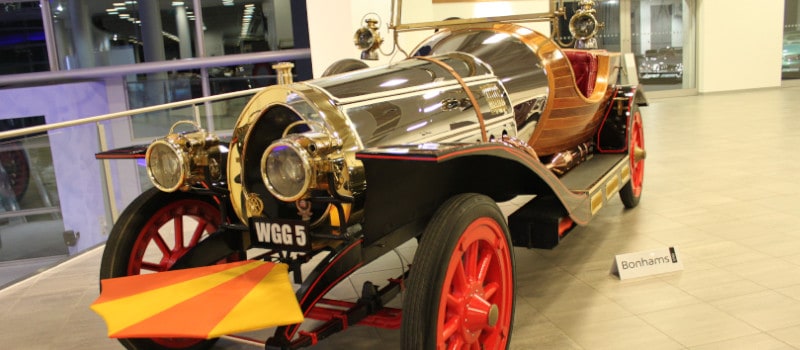
Serious real-life problems we’d have with 5 beloved fictional cars
25th Sep, 2019
Everyone’s got a car they love on the big screen. Whether they’re imbued with special abilities, shining with unique personalities, or they just look super-cool, these fictional automobiles all have one thing in common – they have captured our imaginations (and our hearts). However, when you stop to consider it, even within their fictional universes, many of these vehicles pose some big problems. Disposal is one – we don’t know how we’d react if Batman showed up at our headquarters to say “I need to scrap my car.” Here are five of the biggest icons, and their biggest problems.
The Batmobile
The icon:
No prizes for guessing who owns this eponymous automobile. Ever since its first comic debut around 80 years ago, the Batmobile made such an impact on popular culture that “to the Batmobile!” is still used as a rallying cry by dads and Volkswagen owners everywhere. With so many decades behind it in comics, television and film, the Batmobile has actually gone through several iterations, from a simple red car in its first appearance all the way up to a high-tech motorcycle/tank hybrid in the latest films, with the deceptively perky name of the Tumbler. For the sake of consistency, let’s focus our attention on this latest iteration.

The problems:
The in-universe explanation of the Tumbler is that it was designed as a prototype military vehicle. And in that capacity, it absolutely excels. The main problem is that realistically, the military are the only people who could get decent use out of it. As far as Batman’s concerned, its main issue is stealth. It’s massive, it’s loud, it’s got a rocket booster. Even with the black paint, it doesn’t exactly fade into the night.
As you’ll know if you’ve seen the Dark Knight Rises, at one point Bruce parks it in the middle of downtown Gotham for a dramatic mid-scene reveal – but we never actually see how he got it there. How do you move a vehicle like that through any major city without being spotted, even when you’re Batman? Similarly, he later manages to shake his police tail, but we never really stop to consider how. We’re not trained police pilots, but we imagine it’s pretty hard to lose a tank-sized vehicle, no matter how fast it’s going. Even if you lose sight of it for a few moments, the thing’s roaring like a jet engine. You could probably hear it over the rotors – and what’s more, it’s leading you straight in the direction of Wayne Manor.
As for anyone else using it, forget it. You’d need a Category H licence to drive it, and taking it on the shopping run would be an absolute nightmare. It might be perfectly suited to zooming down the wide streets of Gotham at breakneck speed, but good luck reversing into a parking space (or several) at your local Tesco. We won’t even go into its emissions levels, which are almost certainly not within the latest EU regulations.
Herbie
The icon:
With almost as much history behind it as the Batmobile, Herbie has been gracing our screens since his film debut in 1968. Fondly known as the Love Bug, Herbie is a cheerful, mischievous living racecar who can’t speak, but nonetheless is able to form fiercely loyal relationships with his select few human owners. (No wonder really – science says we’re hardwired to recognise faces and personalities in our cars.)

The problems:
To be honest, we could probably write a whole thesis on the issues that Herbie’s very existence poses. A car with a soul – a living being – immediately creates so many ethical complications with every interaction humans have with him. Does he have any legal rights? If so, who decides them? If not, does that mean he’s technically living in slavery? He might enjoy the racing lifestyle, but who’s to say what he knows of the world? Would he choose something different, if he had the options available?
Admittedly that’s all something of a quagmire there, so let’s think a bit more practically. Let’s assume he’s got rights, he’s exercising them, and he loves racing. Fine. But even his very design causes issues. When a car crashes, it’s designed to fold in on itself, absorbing kinetic energy to protect the occupants. That’s called a crumple zone. For Herbie, his crumple zone is his face. He is flying merrily through life literally face-first, sometimes at 90mph. Does he know about this design quirk? How does he feel about it?
However, at least we know he doesn’t feel pain. This is established in his very first film, in which he wins a race after being literally sawn in half. (“Fifty-Three wins first… and third place!”). But painful or not, as far as we know, he’s still made of normal materials. That means he’ll rust, he’ll degrade, and ultimately come to the end of his useful lifespan. A world with living cars in it makes our job a whole lot more troubling here at Scrap Car Network.
You see, as part of our ongoing commitment to eliminate vehicle waste, we strip down all vehicles for any parts which can be resold, reused or recycled. That transforms the normally-admirable task of car recycling into an existentially horrifying experience, as our skilled technicians strip down Herbie bit by bit, possibly as his consciousness ebbs away – or stays aware and terrified for every second. Then, if his parts are used in other cars, are they grim or even gruesome testaments to an innocent life tragically lived, or does his soul somehow live on? Are they somehow… haunted?
The DeLorean
The icon:
As a concept, the DeLorean is about as 80s as it’s possible to get. A streamlined supercar that doubles as a totally rad time machine, it can only make temporal jumps when accelerated to exactly 88 miles an hour. Throughout its film series, Back To The Future, it’s driven by Marty McFly, a red-blooded American teenager who’s known to say “hey Doc!” quite a lot, as well as its creator, the eccentric Doc Brown himself.

The problems:
We’ll try and stick to issues with the car itself, rather than time travel as a concept. Let’s start with the DeLorean’s power source: a plutonium-fuelled nuclear reactor. Plutonium is not a sustainable fuel source for a car. Even the movies recognise this; fuel problems constitute major plot points in all three films. Ultimately, its reactor is upgraded to a replacement most likely acquired from the future. This enables it to be powered by common litter, which means it may as well run on literal magic for all the logical sense it makes at this stage.
Those are just the problems set out in the films themselves, which Marty and the Doc find themselves going to steadily more ludicrous lengths to solve. What happens if you try to transpose it onto modern UK roads?
Well for starters, getting it to 88 miles an hour is technically not legal on British highways, and supremely dangerous unless you’re on a motorway. The law always takes a very dim view of it, and contrary to what some people say, it’s not even legal when you’re performing an overtake. Achieving that kind of velocity is also going to be a lot more difficult with speed-limiting technology (which will soon be mandatory for all cars manufactured within the EU).
If the car is capable of hovering and flight, as it is in the films, then that also probably disqualifies you from driving it unless you’ve also got a pilot’s licence. Oh, and those gullwing doors will pose a massive problem if you’re bay-parked between two other vehicles at Asda.
The Flintstones Car
The icon:
The beloved animated sitcom is famous for its creative use of anachronisms, and it’s a huge part of what made the Flintstones famous. Living (and occasionally speaking) animals are used as stand-ins for common household appliances, leisure devices like record players, and even vehicles. Fred Flintstone himself works as a bronto-crane operator in a quarry.
However, not every vehicle gets a prehistoric reptile retrofit. Some of the most instantly recognisable hallmarks of this retro Stone Age are, of course, its consumer automobiles. The Flintstones family car is a prime example – instead of an engine, it’s propelled by the running feet of its driver and passenger.

The problems:
Well, where to start? This vehicle does not make travelling easier. It makes running harder. First things first – it’s made partially of rock, which means that Fred and Barney must have godlike thighs and soles of steel in order to even get the thing off the driveway. If they do manage to succeed in getting it up to a good speed, the lack of windscreen may pose a problem. (Hint: there’s a reason road cyclists wear eye protection.)
After that, take your pick. There are no seatbelts. The steering wheel is not connected to anything. It has no realistic way of turning. There is no boot. As a family car, it’s already wildly impractical. There is no central locking system, or any other security. Assuming everyone has a pair of god quads in this universe, literally any random passerby can liberate it from the driveway in seconds. After all, it’s basically a bike/steamroller hybrid with a very light canopy – one that’ll be useless at protecting the occupants from anything more than a light drizzle.
That’s not to say that it doesn’t have its bright sides, of course. It’s made of several columns of rock and a couple of branches, which means it’s very economical to produce. It’s also carbon neutral, and essentially maintenance free. If you trust your neighbours, you can basically leave it anywhere. Scrapping it also becomes an exponentially simpler and easier process. Hang on a second, we’re talking ourselves round to the idea.
Chitty Chitty Bang Bang
The icon:
Chitty Chitty Bang Bang is another sentient vehicle, famous for taking flight at the most thematically dramatic moments. Though it made its movie debut in 1968, it was first introduced to the world by Ian Fleming four years earlier, with his book Chitty Chitty Bang Bang: The Magical Car. Today, it has over fifty years and counting of being our fine, four-fendered friend.

The problems:
First of all, for a flying car it’s not particularly aerodynamic. Modern planes fold up their landing gear so that there’s no drag, whereas Chitty’s wheels remain resolutely in place. Also, it has zero instruments, radar, or any way of communicating with anyone on the ground. That’s incredibly dangerous – even in an age where drones aren’t yet a commonplace consumer product. Also, unless Chitty somehow has VTOL capability, it would also need a runway, or a sharp cliff (which, in fairness, it does use in the film). In fact, we’ve already covered all the real-world obstacles to flying cars in a previous post.
But, we hear you cry, none of that is applicable. Chitty Chitty Bang Bang is the Magical Car, after all. That presumably exempts it from most laws of physics, as well as the issue of fuel or gliding. It’s even been seen to take off without wings. Plus, it doesn’t necessarily need a human driver – as a sentient car, it chooses its own destination. But still, magic may not solve every one of its problems.
For one thing, complex systems of oxygen circulation are designed into modern aeroplanes, borne of years of scientific advancement. Chitty has none of those systems, which means it has to stay below 8000 feet if it doesn’t want its occupants to deal with dizziness, blurred vision or unconsciousness. And even if they survive all that, one huge issue remains.
It’s called a bird strike, and in 2018 alone, US aviation authorities dealt with roughly 40 of them every day. In fact, a Canada goose is classed as one of the single biggest threats to modern aircraft, and they can fly at speeds of up to 70mph if they catch a strong tailwind. An oncoming goose can smash clean through an aircraft’s windows, and they’ve been known to down helicopters. That means Dick Van Dyke might not be so chipper if he gets one straight in the face, especially if he’s not even wearing his goggles. Unless Chitty Chitty Bang Bang also has a secret magic forcefield to protect all its occupants, it’s likely that a trip in the Magical Car isn’t going to end very whimsically at all.
Of course, if we’re discussing iconic fictional cars we must give an honourable mention to James Bond’s DB5, complete with gadgets and all. Unfortunately for this article, a collector actually owns that and everything seems to be fine, so there you go.
Here at Scrap Car Network, we know it can be hard enough to say goodbye to your car, even when it isn’t actually sentient. That’s why we do everything we can to make the process of scrapping your car as easy and stress-free as possible – just enter in your car reg and postcode for a free, no obligation quote! Couldn’t hurt find out what yours is worth, could it?